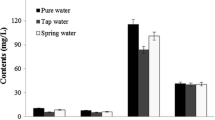Abstract
The purpose of this study was to compare the main components, and particularly catechins, caffeine, theanine, free amino acids, and water extracts, in Bai Hao Yin Zhen, Bai Mu Dan, and Shou Mei Fuding white tea infusions brewed at different temperatures, and their contributions to taste were estimated by dose-over-threshold value. Infusion temperature had a distinct effect on the main components extracted, and 100 °C was found to be optimal for extracting catechins and caffeine. However, the effect of temperature on theanine, free amino acids, and water extracts varied with tea type. Bai Mu Dan and Shou Mei yielded a higher content of the major compounds than did Bai Hao Yin Zhen. Thus, infusion temperature had a large effect on extracting the main compounds, and the differences in content between the three white teas presumably reflected differences in the harvest time, processing method or leaf shape.






Similar content being viewed by others
References
AlHafez M, Kheder F, AlJoubbeh M. Polyphenols, flavonoids and (-)-epigallocatechin gallate in tea leaves and in their infusions under various conditions. Nutr. Food Sci. 44: 455–463 (2014)
Azman NAM, Peiró S, Fajarí L, Julià L, Almajano MP. Radical scavenging of white tea and its flavonoid constituents by electron paramagnetic resonance (EPR) spectroscopy. J. Agric. Food Chem. 62: 5743–5748 (2014)
Damiani E, Bacchetti T, Padella L, Tiano L, Carloni P. Antioxidant activity of different white teas: comparison of hot and cold tea infusions. J. Food Compos. Anal. 33: 59–66 (2014)
Dias TR, Tomás G, Teixeira NF, Alves MG, Oliveira PF, Silva BM. White tea (Camellia Sinensis (L.)): antioxidant properties and beneficial health effects. Int. J. Food Sci. Nutr. Diet. 2: 19–26 (2013)
Hajiaghaalipour F, Kanthimathi MS, Sanusi J, Rajarajeswaran J. White tea (Camellia sinensis) inhibits proliferation of the colon cancer cell line, HT-29, activates caspases and protects DNA of normal cells against oxidative damage. Food Chem. 169: 401–410 (2015)
Hajiaghaalipour F, Sanusi J, Kanthimathi MS. Temperature and time of steeping affect the antioxidant properties of white, green, and black tea infusions. J Food Sci. 81: H246–H254 (2016)
Kilel EC, Faraj AK, Wanyoko JK, Wachira FN, Mwingirwa V. Green tea from purple leaf coloured tea clones in Kenya-their quality characteristics. Food Chem. 141: 769–775 (2013)
Kocadağlı T, Özdemir KS, Gökmen V. Effects of infusion conditions and decaffeination on free amino acid profiles of green and black tea. Food Res. Int. 53: 720–725 (2013)
Lantano C, Rinaldi M, Cavazza A, Barbanti D, Corradini C. Effects of alternative steeping methods on composition, antioxidant property and colour of green, black and oolong tea infusions. J Food Sci. Technol. 52: 8276–8283 (2015)
Narukawa M, Kimata H, Noga C, Watanabe T. Taste characterisation of green tea catechins. Int. J. Food Sci. Technol. 45: 1579–1585 (2010)
Ning JM, Ding D, Song YS, Zhang ZZ, Luo X, Wan XC. Chemical constituents analysis of white tea of different qualities and different storage times. Eur. Food Res. Technol. 242: 2093–2104 (2016)
Nunes AR, Alves MG, Tomás GD, Conde VR, Cristóvão AC, Moreira PI, Oliveira PF, Silva BM. Daily consumption of white tea (Camellia sinensis (L.)) improves the cerebral cortex metabolic and oxidative profile in prediabetic Wistar rats. Br. J. Nutr. 113: 832–842 (2015)
Ramalho SA, Nigam N, Oliveira GB, Pa O, Tom S, Santos AGP, Narain N. Effect of infusion time on phenolic compounds and caffeine content in black tea. Food Res. Int. 51: 155–161 (2013)
Rusak G, Komes D, Likic S, Horzic D, Kovac M. Phenolic content and antioxidative capacity of green and white tea extracts depending on extraction conditions and the solvent used. Food Chem. 110: 852–858 (2008)
Saklar S, Ertas E, Ozdemir IS, Karadeniz B. Effects of different brewing conditions on catechin content and sensory acceptance in Turkish green tea infusions. J. Food Sci. Technol. 52: 6639–6646 (2015)
Scharbert S, Hofmann T. Molecular definition of black tea taste by means of quantitative studies, taste reconstitution, and omission experiments. J. Agric. Food Chem. 53: 5377–5384 (2005)
Song JL, Zhou Y, Feng X, Zhao X. White tea (Camellia sinenesis (L.)) ethanol extracts attenuate reserpine-induced gastric ulcers in mice. Food Sci. Biotechnol. 24: 1159–1165 (2015)
Tan J, Engelhardt UH, Lin Z, Kaiser N, Maiwald B. Flavonoids, phenolic acids, alkaloids and theanine in different types of authentic Chinese white tea samples. J. Food Compos. Anal. 57: 8–15 (2017)
Yu P, Yeo AS, Low MY, Zhou W. Identifying key non-volatile compounds in ready-to-drink green tea and their impact on taste profile. Food Chem. 155: 9–16 (2014)
Zhang H, Li Y, Lv Y, Jiang Y, Pan J, Duan Y, Zhu Y, Zhang S. Influence of brewing conditions on taste components in Fuding white tea infusions. J. Sci. Food Agric. 97: 2826–2833 (2017)
Zielinski AAF, Haminiuk CWI, Beta T. Multi-response optimization of phenolic antioxidants from white tea (Camellia sinensis L. Kuntze) and their identification by LC–DAD–Q-TOF–MS/MS. LWT-Food Sci. Technol. 65: 897–907 (2016)
Acknowledgements
The project was supported by the National Key Technology R&D Program (2012BAD36B06).
Author information
Authors and Affiliations
Corresponding author
Rights and permissions
About this article
Cite this article
Pan, J., Jiang, Y., Lv, Y. et al. Comparison of the main compounds in Fuding white tea infusions from various tea types. Food Sci Biotechnol 27, 1311–1318 (2018). https://doi.org/10.1007/s10068-018-0384-3
Received:
Revised:
Accepted:
Published:
Issue Date:
DOI: https://doi.org/10.1007/s10068-018-0384-3




